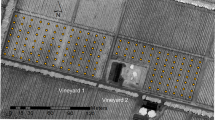Abstract
Field experiments were carried out in a forest nursery during the summer of 1994 to examine the effect of soil solarization on ectomycorrhizal soil infectivity (ESI) and soil receptiveness to inoculation with Laccaria bicolor. Soil samples from solarized, steamed, fumigated and untreated plots were periodically collected and assayed for ESI. Untreated soil exhibited high ESI. Solarization was as effective as steaming or fumigation in reducing ESI in the uppermost layer. Solarization with a double layer of polyethylene film and fumigation were the only treatments which reduced ESI deeper in the soil. During July, the temperature of covered beds reached 50 °C at a soil depth of 5 cm. Ectomycorrhizal fungi were among the soil-borne fungi most sensitive to solar heating. Soil solarization provides an effective disinfection method for controlled mycorrhization in forest nurseries.
Similar content being viewed by others
Author information
Authors and Affiliations
Additional information
Accepted: 10 April 1997
Rights and permissions
About this article
Cite this article
Soulas, M., Bihan, B., Camporota, P. et al. Solarization in a forest nursery: effect on ectomycorrhizal soil infectivity and soil receptiveness to inoculation with Laccaria bicolor . Mycorrhiza 7, 95–100 (1997). https://doi.org/10.1007/s005720050168
Issue Date:
DOI: https://doi.org/10.1007/s005720050168




